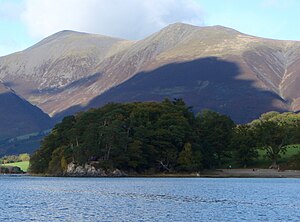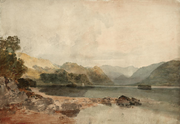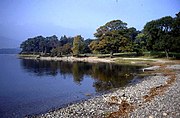Background and description
The 7th-century priest and hermit Saint Herbert lived on an island in Derwentwater. Friars' Crag derives its name from its use as an embarkment point by monks making a pilgrimage to the island. [4] Both Friars' Crag and St Herbert's Island are now owned by the National Trust. [5] The crag is at the end of a promontory about half a mile south of the modern boat landing-stages at Keswick, and is reached by a footpath along the eastern side of the lake. [4]
Friars' Crag has been valued as a beauty spot since at least the 18th century. The poet Robert Southey said of it, "If I had Aladdin's lamp, or Fortunatus's purse, I would here build myself a house". [6] J. M. W. Turner painted the view from the crag in either the late 18th or early 19th century. [7] The art critic and social reformer John Ruskin wrote of the spot:
"The first thing that I remember as an event in life was being taken by my nurse to the brow of Friars' Crag, Derwentwater. The intense joy mingled with awe that I had in looking through the hollows in the mossy roots over the crag into the dark lake has associated itself more or less with all twining roots of trees ever since".
[8] Ruskin, a pioneer of the protection of the unspoiled beauty of the Lake District, said that the view from Friars' Crag "is one of the three or four most beautiful in Europe". [9] In October 1900, nine months after his death, a monument to Ruskin was unveiled at the side of the path to Friars' Crag. [1] The driving force behind the erection of the Ruskin memorial was Hardwicke Rawnsley, one of the three founders of the National Trust. He died in 1920, and in his memory the trust raised money to buy Friars' Crag and the surrounding land. A memorial to him was installed in 1922. [10]
The children's author Arthur Ransome incorporated Friars' Crag into his Swallows and Amazons (1930), where it is given the name "Darien", the look-out point for the young crew of the Swallow. [2]
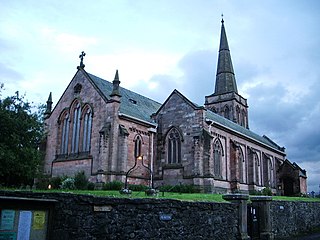
Keswick is a market town and civil parish in the Cumberland unitary authority area of Cumbria, England. Historically, until 1974, it was part of the county of Cumberland. It lies within the Lake District National Park, just north of Derwentwater and four miles from Bassenthwaite Lake. The parish had a population of 5,243 at the 2011 census.

Coniston Water is a lake in the Lake District in North West England. It is the third largest by volume, after Windermere and Ullswater, and the fifth-largest by area. The lake has a length of 8.7 kilometres, a maximum width of 730 metres (800 yd), and a maximum depth of 56.1 m. Its outflow is the River Crake, which drains into Morecambe Bay via the estuary of the River Leven. The lake is in the unitary authority of Westmorland and Furness, and the ceremonial county of Cumbria.
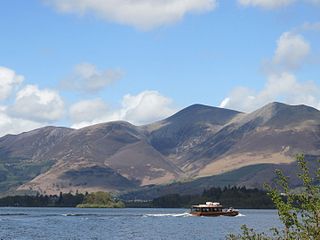
Skiddaw is a mountain in the Lake District National Park in England. Its 931-metre (3,054 ft) summit is traditionally considered to be the fourth-highest peak but depending on what topographic prominence is thought to be significant is also variously ranked as the third- and the sixth-highest in England. It lies just north of the town of Keswick, Cumbria, and dominates the skyline in this part of the northern lakes. It is the simplest of the Lake District mountains of this height to ascend and, as such, many walking guides recommend it to the occasional walker wishing to climb a mountain. This is the first summit of the fell running challenge known as the Bob Graham Round when undertaken in a clockwise direction.

Hardwicke Drummond Rawnsley was an Anglican priest, poet, local politician and conservationist. He became nationally and internationally known as one of the three founders of the National Trust for Places of Historic Interest or Natural Beauty in the 1890s.

Borrowdale is a valley and civil parish in the English Lake District in Cumberland, England. It is in the ceremonial county of Cumbria, and is sometimes referred to as Cumberland Borrowdale to distinguish it from another Borrowdale in the historic county of Westmorland.

Cat Bells is a fell in the English Lake District in the county of Cumbria. It has a height of 451 metres (1,480 ft) and is one of the most popular fells in the area. It is situated on the western shore of Derwentwater within three miles of the busy tourist town of Keswick. Its distinctive shape catches the attention of many visitors to the Lakes who feel compelled to climb to the summit after seeing it from the viewpoint of Friars' Crag on the opposite side of Derwentwater. The Lake District writer and walker Alfred Wainwright acknowledges the popularity of Cat Bells among fellwalkers of all abilities by saying:
"It is one of the great favourites, a family fell where grandmothers and infants can climb the heights together, a place beloved. Its popularity is well deserved: its shapely topknott attracts the eye offering a steep but obviously simple scramble."
Saint Herbert of Derwentwater was an Anglo-Saxon priest and hermit who lived on the small St Herbert's Island in Derwentwater, Cumbria, England. His friendship with St Cuthbert is explored in a poem by William Wordsworth.
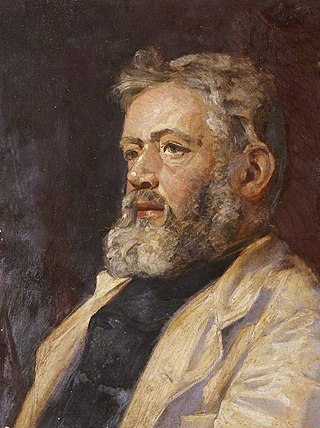
William Gershom Collingwood was an English author, artist, antiquary and professor of Fine Arts at University College, Reading. A long-term resident of Coniston, Cumbria, he was President of the Cumberland and Westmorland Antiquarian Society (1920-32) and the Lake Artists' Society.
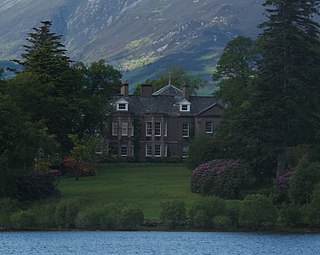
Derwent Island House is a Grade II listed 18th-century Italianate house situated on the seven-acre (three-hectare) Derwent Island, Derwent Water, Keswick, Cumbria, and in the ownership of the National Trust. It is leased as a private home, but is open to the public five days a year. The interior is neoclassical in style.

Keswick School of Industrial Art (KSIA) was founded in 1884 by Canon Hardwicke Rawnsley and his wife Edith as an evening class in woodwork and repoussé metalwork at the Crosthwaite Parish Rooms, in Keswick, Cumbria. The enterprise, designed to alleviate unemployment, prospered, and within ten years more than a hundred men were attending classes. A new building was erected for the school at a nearby site.

Wray Castle is a Victorian neo-gothic building at Claife in Cumbria within the boundaries of the historic county of Lancashire. The house and grounds have belonged to the National Trust since 1929, with the house open to the public on a regular basis since 2013. The grounds, which include part of the shoreline of Windermere, are open all year round and are renowned for their selection of specimen trees – Wellingtonia, redwood, Ginkgo biloba, weeping lime and varieties of beech.

Keswick Museum is a local museum based in Keswick in the English Lake District, which exhibits aspects of the landscape, history and culture of the area.
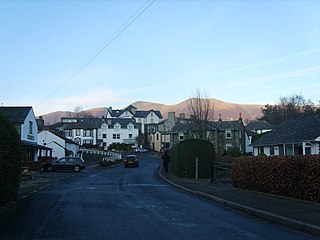
Portinscale is a village in Cumbria, England, close to the western shore of Derwentwater in the Lake District National Park 1+1⁄2 miles from Keswick.

Crosthwaite Parish Church is a church at Great Crosthwaite on the outskirts of Keswick in Cumbria, England. It is dedicated to St Kentigern and is the Anglican church of the parish of Crosthwaite. Since 1951 it has been a Grade II* listed building. The church has an evangelical tradition.

Barrow House is a late 18th-century mansion situated on the eastern shore of Derwentwater in Borrowdale within the Lake District National Park, in the county of Cumbria, England. The house is a Grade II listed building which since the time of its construction has had various uses: it was originally a private dwelling and has since served as a hotel, a youth hostel run by the YHA, and was then an independent hostel until March 2024.

Greta Hall is a house in Keswick in the Lake District of England. It is best known as the home of the poets Samuel Taylor Coleridge and Robert Southey.

The Moot Hall is a prominent historic building situated at the southern end of Main Street in Keswick, Cumbria, England. It is Grade II* listed.

The Ruskin Monument is a memorial to John Ruskin located on the edge of Derwentwater in the English Lakes at Friars' Crag, Keswick, Cumbria. It was erected on 6 October 1900, shortly after his death, largely through the efforts of Hardwicke Rawnsley.

Richardson Henderson was a grandson of musician Joseph Richardson, who invented the Rock, Bell, and Steel Band from musical stones on the mountain of Skiddaw in Cumbria.
